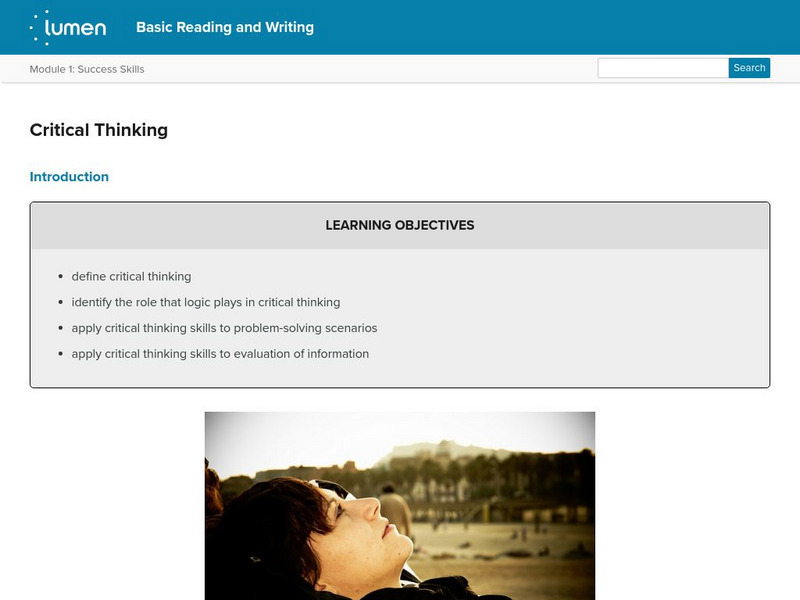Sophia Learning
Sophia: Judging and Reacting: Tutorial
In this slideshow tutorial, students will review the critical reading techniques of making judgments and forming reactions about what they read. Explanations are given about drawing conclusions, responding to literature, and making...
Colorado State University
Colorado State Writing Center: Writing the Scientific Paper
A guide to the world of writing in the scientific field. Includes information about scientific-format papers, abstracts, hypotheses and results, and provides several examples.
Texas Education Agency
Texas Gateway: The Writing Process: Generate Ideas and Questions
[Accessible by TX Educators. Free Registration/Login Required] Learn strategies to help you generate questions and ideas about a topic.
Texas Education Agency
Texas Gateway: Annotate and Analyze a Paired Passage: Practice 1
Read and annotate paired texts in order to make inferences, draw conclusions, and synthesize ideas and details using textual evidence.
Lumen Learning
Lumen: Boundless Communications: Gathering Evidence: An Overview
This lesson plan focuses on the importance of gathering information that provides evidence for your topic that is credible, current, and relevant. It also discusses how to find and evaluate sources. SL.9-10.1a Prepared/Discuss
Lumen Learning
Lumen: Success Skills: Critical Thinking
This activity focuses on critical thinking including a definition, examples, a video of critical thinking in action, logic in critical thinking, questions a critical thinker asks, guidelines for critical thinking, problem-solving, and...
Online Writing Lab at Purdue University
Purdue University Owl: Academic Writing: Reverse Paramedic Method
Explanations and examples of the Reverse Paramedic Method used to edit scientific writing.
Lumen Learning
Lumen: Analysis: Suspend Judgment
This article focuses on the need to suspend judgment and keep an open mind while analyzing a situation or researching a topic.
Lumen Learning
Lumen: Analysis: Process Analysis
This lesson focuses on process analysis including processes by people, machines, and nature. They can be classified as descriptive and prescriptive. It also includes a practice activity.
Lumen Learning
Lumen: Evaluating Sources: Introduction to Multimedia Sources
An introduction to methods of evaluating multimedia sources.
Lumen Learning
Lumen: Using Sources: Building Credibility Through Source Integration
This lesson focuses on building credibility by properly integrating source materials. It discusses three ways of improving credibility through integration, provides an example, and a practice exercise. SL.9-10.2 eval & integrate...
Lumen Learning
Lumen: Using Sources: Paraphrase and Summary
This lesson focuses on how to integrate source material using paraphrase and summary and the differences between the two. It also provides a practice exercise.
Lumen Learning
Lumen: Using Sources: Putting It Together: Using Sources
This is a summary of the lessons on integrating credible sources using paraphrase, summary, and quotations and citing sources. Click on the Next button on the bottom right to learn about Why It Matters: Multimodality; you will have the...
Lumen Learning
Lumen: Critical Reading: Logic and Structure
This instructional activity focuses on structure and logic including types and purposes of essays, organizational patterns, argumentative writing, and logic and fallacies.
Lumen Learning
Lumen: Research Process: Introduction to the Research Process
This lesson focuses on the reliability of research sources including a video example. It also lists the learning objectives for researching.
Lumen Learning
Lumen: Research Process: Finding Sources
This lesson focuses on how to find sources including information on research strategies: preliminary, intermediate, and advanced. It provides a variety of resources available in each level including videos: " How To Google Like A Pro!...
Lumen Learning
Lumen: Research Process: Conclusion to Research Process
This article focuses on the real purpose of research, to learn about the subject of the investigation as much as possible and then form those theories, opinions, and arguments on the basis of this newly found knowledge and understanding...
University of Minnesota
University of Minnesota: Assignment Calculator
Want a realistic timeline for that research project? Use these tips and resources to get a handle on what to do and when to do it. It offers templates several types of research projects such as speech, media project, primary sources,...
University of Victoria (Canada)
Uvcs: Critical Reading Exercise
Students read quotations from different "interest groups" or "lobbies" in this exercise and then perform a multiple-choice test to evaluate the credibility of each lobby group.
CPALMS
Cpalms: Lafs.1112.rst.1.3: Follow Precisely a Complex Multistep Procedure
Find a collection of standards-aligned teacher and student resources where students follow procedural text.
Other
Learning Design Collaborative: Cer: Claim, Evidence, and Reasoning
Students write a scientific claim that is backed up by evidence and supported by scientific reasoning. Base your answer on your reading of a data table.
Other
Csicop: Field Guide to Critical Thinking
This article, originally published in Skeptical Inquirer, outlines some of the key components of the scientific problem-solving process while addressing the many reasons for the popularity of paranormal beliefs in the U.S. (Published in...
CommonLit
Common Lit: Units: Teaching Units
Complete teaching units (12) by grade level. CommonLit units are crafted to be both engaging and rigorous, featuring a variety of literary and informational texts from diverse sources. Reading, writing, and discussion are prioritized in...
Khan Academy
Khan Academy: Types of Conclusions
You might find it helpful to categorize the kind of conclusion you're dealing with as you approach passages that contain arguments on the LSAT. Your success in analyzing arguments-passages with a conclusion and supporting evidence-starts...






















